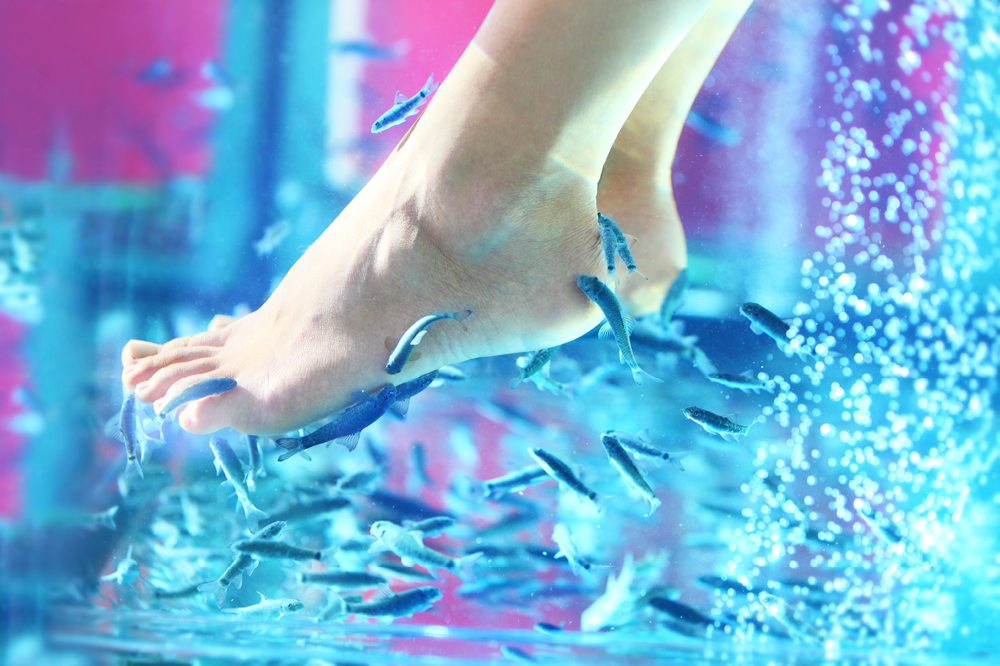Doctor fish pedicures have created quite a de-bait in the beauty world. Some say the pedicures are an age-old health and cleansing practice that softens the skin and has the ability to rid feet of calluses and ailments like eczema and psoriasis. Others insist that fish footbaths aren't good for hygiene as they spread infections and are dangerous for your health. So, which is it? We waded through the ocean of information and have reeled in the truth about this very fishy beauty ritual: The Centers For Disease Control and Prevention (CDC) has determined that though customers should use caution when receiving garra rufa fish pedicures, the carp and fish pedicures are NOT responsible for the spread of foot and spa infections.
What Is a Fish Pedicure?

One of the strangest trends to hit the beauty world in some time, fish pedicures are similar to traditional pedicures in all but one area: the removal of dead skin. Typical pedicures remove calluses and dead skin with a pumice stone or a metal foot file, while fish pedicures handle the calluses in an entirely different way: small carp fish called garra rufa fish (or doctor fish) nibble the calluses and dead skin off of the feet.
Originally hailing from Turkey, Iran, Iraq and Syria, garra rufa fish have long been used for skin softening as well as for relieving and sometimes even curing conditions like eczema and psoriasis. Asian countries first began exporting the fish for use in salons and spas, and Europe picked up on the spa trend not long after. Fish pedicures finally hit the United States when Yvonne Hair and Nails in Alexandra, Virginia, offered the very first garra rufa fish pedicures in 2008. Now, the spa trend has spread to several states and typically costs anywhere from $40 to $100, depending on the salon, the length of service and other factors.
Do Fish Pedicures Hurt?
Garra rufa fish are unique in that they actually don’t have any teeth, meaning they are merely sucking and nibbling the dead skin off of your feet for the duration of the pedicure. Many people say the experience is ticklish at first and then slightly tingly — but never painful. And the fish are used to sucking skin: In the wild, the carp survive by nibbling dead scales off of other fish, so your tootsies are actually quite a delicatessen for the little swimmers.
Are Fish Pedicures Safe and Sanitary?
Reputable salons and spas in the United States keep doctor fish pedicures as sanitary as possible by following a variety of different hygiene procedures, including:
- Storing the fish in filtered, UV-lit communal tanks
- Transferring the fish to personal baths for each pedicure and rotating the fish used so that each fish is only averaging one to few pedicures per day
- Keeping the personal foot baths clean with filtration systems that sanitize and refresh the water regularly
- Inspecting each client’s feet to make sure there are no open wounds, cuts or infections before the pedicure begins
However, fish pedicures have created a lot of controversy and have therefore been banned in several states. Though no infections or illnesses have been reported from fish pedicures, experts at the Centers for Disease Control (CDC) argue that no matter what steps are taken to keep fish footbaths sanitary, there’s no way to completely ensure a customer won’t catch an infection or a disease from the procedure.

What Are the Risks the CDC Warns About?
The CDC states the following reasons why people should be cautious of fish pedicures:
- There’s no way to completely sanitize the fish between customers, and fully sanitizing the tanks and tubs is impossible when the fish are present
- Fish are living creatures and deposit their waste products in the water (it’s a natural process called ichthyotherapy), and there’s no way to fully remove the waste before and during a pedicure
- Some garra rufa fish have been found to carry Streptococcus agalactiae (group B Streptococcus), a bacteria that can cause pneumonia as well as serious infections of the bones, joints and blood
- Some garra rufa fish have been found to carry other types of bacteria, including Vibrio vulnificus, Vibrio cholorae and S. agalactiae — strains which David W. Verner-Jeffreys, an aquaculture health specialist from England, found to be resistant to many antimicrobial medications
- Chinese Chinchin fish look very similar to garra rufa and are sometimes mistaken for and sold as their toothless twin. The problem is that chinchin fish have teeth, meaning they can draw blood and spread infection
- Customers with open sores and cuts and those with underlying medical conditions like diabetes or compromised immune systems from things like HIV, AIDS, cancer and age are particularly vulnerable to catching and spreading infection via fish pedicures
- The fish are typically starved of plants and other aquatic material so they are more enticed to eat dead human skin — a practice some consider to be animal cruelty
The Final Verdict: Yes or No to Fish Pedicures?
There may be risks associated with fish pedicures, but aquaculture health specialist Verner-Jeffreys says the danger is minimal. “The most important thing to stress at this point is the U.K. Health Protection Authority considers the human health risks to be very low, and we would not want [anyone] to be unduly alarmed by our findings,” he stated to ABC News.
Furthermore, while there have been no illnesses or diseases reported from fish pedicures, infections from traditional pedicures have been reported — meaning the carp-filled beauty ritual may actually be less risky than typical pedicures. And that means the “reel” good news is this: It’s completely okay to get hooked on doctor fish pedicures. So jump on in!


